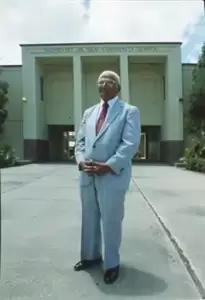Education: The Junior Colleges
Due to the Korean War, in 1951 Palm Beach Junior College was evicted from its quarters at Morrison Field (now Palm Beach International Airport), when it was reactivated as a military base. The college moved into cramped quarters in the Lake Park Town Hall, with classes spilling into the jail and the neighboring church. Drastic reductions in faculty and students, however, resulted in memories of a close-knit environment among alumni, which included actor Burt Reynolds.
The Board of County Commissioners gave the college 114 acres out of what is now John Prince Memorial Park in Lake Worth, and with state funding for construction, PBJC reopened in 1956 at its first permanent campus.

In 1958, four years after the U.S. Supreme Court ruled that segregated schools were unconstitutional in Brown v. Board of Education, the Palm Beach County School District opened all-black Roosevelt Junior College on 15th Street, east of Australian Avenue, in West Palm Beach. The nearest other college open to blacks was Bethune-Cookman in Daytona Beach. Britton G. Sayles was the first and only president of Roosevelt, as well as principal of Roosevelt High School, which shared its campus for the first year.
West Palm Beach attorney William M. “Bill” Holland, whose lawsuit would end segregation in Palm Beach County public schools, recruited Mary Warren, his secretary and a National Honor Society student at Roosevelt, to be the first black student at Palm Beach Junior College in 1961. Warren later earned a master’s degree at Florida Atlantic University.
In 1965, a year after Roosevelt Junior College was fully accredited, a government mandate for integration prompted the Board of Public Instruction to eliminate Roosevelt, or lose more than a half million dollars in federal funding. Roosevelt merged with Palm Beach Junior College. Fewer than half of Roosevelt’s 225 students and six of its 18 faculty moved to PBJC, creating the first county school with an integrated faculty. Of the six, three were teachers—Ruby Bullock, Daniel Hendrix, and Carrie Bridwell. Dean Paul Butler became a PBJC guidance counselor, and librarians Margaret Brown Richardson and Idella Wade moved to the PBJC library.
The Roosevelt building was used for other purposes and later demolished; it stood on what became Roosevelt Middle School’s athletic field. The social science building at Palm Beach Community College was named for Britton Sayles.
Dr. Harold Manor (1958-1978) was the second president of Palm Beach Junior College, followed by Dr. Edward M. Eissey. A Board of Trustees replaced the county school board as legal custodian of the college in 1968. The first branch campus opened in 1978, in Belle Glade.
Marymount College of Boca Raton (now Lynn University) was established in 1962 as a two-year women’s Catholic college, part of a network of colleges founded by the religious order of the Sacred Heart of Mary. It is located on Military Trail, between Yamato and Glades roads.
When the school was failing in 1971, Dr. Donald E. Ross arrived from Delaware to take the library back to Wilmington College, which he had founded with his wife, Helen, four years earlier. Instead, the Rosses stayed in Boca Raton. The school was controlled by a lay board during a transitional period, while Ross strengthened it through partnerships with business, community, and international leaders.
Marymount became the College of Boca Raton in 1974, and was accredited as a four-year college at the graduate level in 1988.

